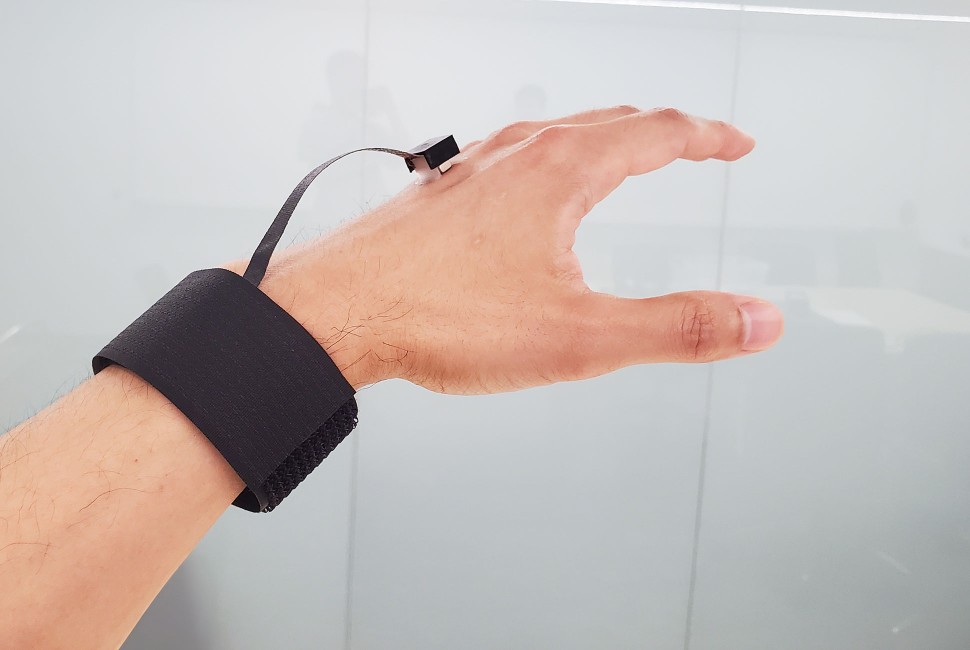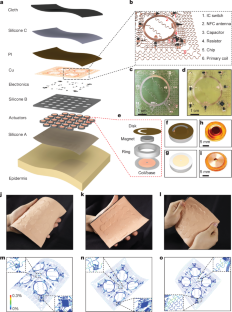2025-03-27 ノースウェスタン大学
 Northwestern University engineers have unveiled a new technology that creates precise movements to mimic complex tactile sensations, including pressure, vibration, stretching, sliding and twisting.
Northwestern University engineers have unveiled a new technology that creates precise movements to mimic complex tactile sensations, including pressure, vibration, stretching, sliding and twisting.
<関連情報>
- https://news.northwestern.edu/stories/2025/03/feeling-the-future-new-wearable-device-mimics-the-complexity-of-human-touch/
- https://www.science.org/doi/10.1126/science.adt2481
- https://www.nature.com/articles/s41586-019-1687-0
高度な触覚インターフェースとしての完全自由度アクチュエータ Full freedom-of-motion actuators as advanced haptic interfaces
Kyoung-Ho Ha, Jaeyoung Yoo, Shupeng Li, Yuxuan Mao, […], and John A. Rogers
Science Published:27 Mar 2025
DOI:https://doi.org/10.1126/science.adt2481
Editor’s summary
Our sense of touch provides a wide range of sensations that tell us about the environment around us, including many things that we can’t ascertain using sight alone. These signals come from a rich collection of receptors that exist in the skin. Ha et al. developed a single actuator unit that can exert complex combinations of dynamic forces, including pressure, shear, vibration, displacement, and torque, to achieve haptic information transfer and realistic virtual tactile sensations. The authors demonstrate the application of this system in hand navigation, reproduction of textural sensation, and tactile perception of music, with a broader goal of using the actuator for biomedical and extended reality applications. —Marc S. Lavine
Abstract
The sense of touch conveys critical environmental information, facilitating object recognition, manipulation, and social interaction, and can be engineered through haptic actuators that stimulate cutaneous receptors. An unfulfilled challenge lies in haptic interface technologies that can engage all the various mechanoreceptors in a programmable, spatiotemporal fashion across large areas of the body. Here, we introduce a small-scale actuator technology that can impart omnidirectional, superimposable, dynamic forces to the surface of skin, as the basis for stimulating individual classes of mechanoreceptors or selected combinations of them. High-bit haptic information transfer and realistic virtual tactile sensations are possible, as illustrated through human subject perception studies in extended reality applications that include advanced hand navigation, realistic texture reproduction, and sensory substitution for music perception.
仮想現実と拡張現実のための皮膚統合型ワイヤレス触覚インターフェース Skin-integrated wireless haptic interfaces for virtual and augmented reality
Xinge Yu,Zhaoqian Xie,Yang Yu,Jungyup Lee,Abraham Vazquez-Guardado,Haiwen Luan,Jasper Ruban,Xin Ning,Aadeel Akhtar,Dengfeng Li,Bowen Ji,Yiming Liu,Rujie Sun,Jingyue Cao,Qingze Huo,Yishan Zhong,ChanMi Lee,SeungYeop Kim,Philipp Gutruf,Changxing Zhang,Yeguang Xue,Qinglei Guo,Aditya Chempakasseril,Peilin Tian,… John A. Rogers
Nature Published:20 November 2019
DOI:https://doi.org/10.1038/s41586-019-1687-0

Abstract
Traditional technologies for virtual reality (VR) and augmented reality (AR) create human experiences through visual and auditory stimuli that replicate sensations associated with the physical world. The most widespread VR and AR systems use head-mounted displays, accelerometers and loudspeakers as the basis for three-dimensional, computer-generated environments that can exist in isolation or as overlays on actual scenery. In comparison to the eyes and the ears, the skin is a relatively underexplored sensory interface for VR and AR technology that could, nevertheless, greatly enhance experiences at a qualitative level, with direct relevance in areas such as communications, entertainment and medicine. Here we present a wireless, battery-free platform of electronic systems and haptic (that is, touch-based) interfaces capable of softly laminating onto the curved surfaces of the skin to communicate information via spatio-temporally programmable patterns of localized mechanical vibrations. We describe the materials, device structures, power delivery strategies and communication schemes that serve as the foundations for such platforms. The resulting technology creates many opportunities for use where the skin provides an electronically programmable communication and sensory input channel to the body, as demonstrated through applications in social media and personal engagement, prosthetic control and feedback, and gaming and entertainment.

